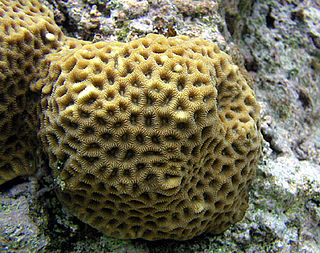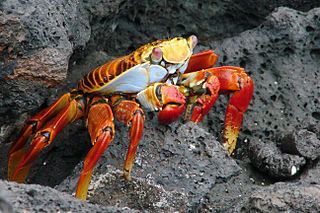
The mousebirds are birds in the order Coliiformes. They are the sister group to the clade Eucavitaves, which includes the Leptosomiformes, Trogoniformes (trogons), Bucerotiformes, Piciformes and Coraciformes. This group is now confined to sub-Saharan Africa, and it is the only bird order confined entirely to that continent, with the possible exception of turacos which are considered by some as the distinct order Musophagiformes, and the cuckoo roller, which is the only member of the order Leptosomiformes, and which is found in Madagascar but not mainland Africa. Mousebirds had a wider range in the Paleogene, with a widespread distribution in Europe and North America during the Paleocene.

Henri Milne-Edwards was an eminent French zoologist.

Alphonse Milne-Edwards was a French mammalogist, ornithologist, and carcinologist. He was English in origin, the son of Henri Milne-Edwards and grandson of Bryan Edwards, a Jamaican planter who settled at Bruges.

Brain coral is a common name given to various corals in the families Mussidae and Merulinidae, so called due to their generally spheroid shape and grooved surface which resembles a brain. Each head of coral is formed by a colony of genetically identical polyps which secrete a hard skeleton of calcium carbonate; this makes them important coral reef builders like other stony corals in the order Scleractinia. Brain corals are found in shallow warm water coral reefs in all the world's oceans. They are part of the phylum Cnidaria, in a class called Anthozoa or "flower animals". The lifespan of the largest brain corals is 900 years. Colonies can grow as large as 1.8 m (6 ft) or more in height.
Frank Morton Carpenter was an American entomologist and paleontologist. He received his PhD from Harvard University, and was curator of fossil insects at the Harvard Museum of Comparative Zoology for 60 years. He studied the Permian fossil insects of Elmo, Kansas, and compared the North American fossil insect fauna with Paleozoic taxa known from elsewhere in the world. A careful and methodical worker, he used venation and mouthparts to determine the relationships of fossil taxa, and was author of the Treatise volume on Insects. He reduced the number of extinct insect orders then described from about fifty to nine.

The Grapsidae are a family of crabs known variously as marsh crabs, shore crabs, or talon crabs. The family has not been confirmed to form a monophyletic group and some taxa may belong in other families. They are found along the shore among rocks, in estuaries, marshes, and in some cases pelagic among drifting seaweeds and flotsam.

Elaphurus is a genus of deer. E.davidianus is only extant species and several fossil species are described.

Calappidae is a family of crabs containing 16 genera, of which 7 are only known as fossils:

Potamonautidae is a family of freshwater crabs endemic to Africa, including the islands of Madagascar, the Seychelles, Zanzibar, Mafia, Pemba, Bioko, São Tomé, Príncipe and Sherbro Island. It comprises 18 extant genera and 138 extant species. Fossil remains dating from the Late Miocene period have been attributed to the family Potamonautidae.

Carpilioidea is a superfamily of crabs containing a single extant family, Carpiliidae and three extinct families. The modern range of the family includes the Indo-Pacific, Western Atlantic and Caribbean Sea. The fossil record of the group extends back at least as far as the Paleocene.

Pilumnoidea is a superfamily of crabs, whose members were previously included in the Xanthoidea. The three families are unified by the free articulation of all the segments of the male crab's abdomen and by the form of the gonopods. The earliest fossils assigned to this group are of Eocene age.

Trichodactylidae is a family of crabs, in its own superfamily, Trichodactyloidea. They are all freshwater animals from Central and South America, including some offshore islands, such as Ilhabela, São Paulo. Only one of the 50 species is known from the fossil record, Sylviocarcinus piriformis from the Miocene of Colombia. The family contains 15 genera in two subfamilies:

Palicoidea is a superfamily of crabs, comprising the two families Crossotonotidae and Palicidae. Together, they contain 13 genera, including two genera in the Palicidae known only from fossils. The two families were previously treated as two subfamilies in a Palicidae of wider circumscription.

Lithostrotion is a genus of rugose coral which is commonly found as a fossil within Carboniferous Limestone. Lithostrotion is a member of the family Lithostrotionidae. The genus Lithostrotion, a common and readily recognised group of fossils, became extinct by the end of the Palaeozoic era.

Isastrea is an extinct genus of corals that lived during the Jurassic and Cretaceous periods. Its fossils have been found in Europe, Africa, North America, Asia and South America.
Jules Haime was a French geologist, paleontologist and zoologist known for his research of coral.

Harpactocarcinus is an extinct genus of mud crabs.
Agnopterus is an extinct genus of stem-flamingo phoenicopteriform with fossil material from France, as well as possibly England, Kazakhstan, and Brazil. The holotype specimen for type species A. laurillardi is an incomplete distal tibiotarsus from Late Eocene gypsum from Paris; a coracoid, humeri, a scapula and perhaps a proximal femur have been recovered from Late Eocene to Early Oligocene of England to a possible second species, A. hantoniensis. Two additional species from the Late Oligocene-Early Miocene have been named as well. A. turgaiensis of Kazakhstan and A. sicki of Brazil. While all four species are considered to be close to the ancestry of flamingos, their exact relationships and placement as members of Agnopterus is uncertain.
Elornis is an extinct genus of flamingo from the Late Oligocene of Ronzon, France. Although the name was coined in the 1850s, the name remained a nomen nudum until later publications by French zoologist Henri Milne-Edwards. Elornis has been historically considered to be a member of the Phoenicopteridae, but more recent research suggests it may have been more basal. Research on this taxon is however difficult as the current whereabouts of the fossil material are unknown, limiting data to the description and illustrations of Milne-Edwards.














